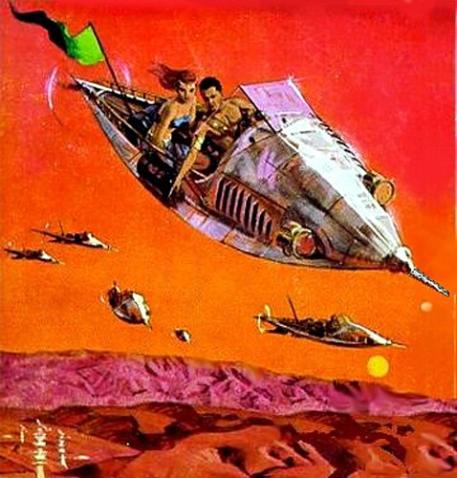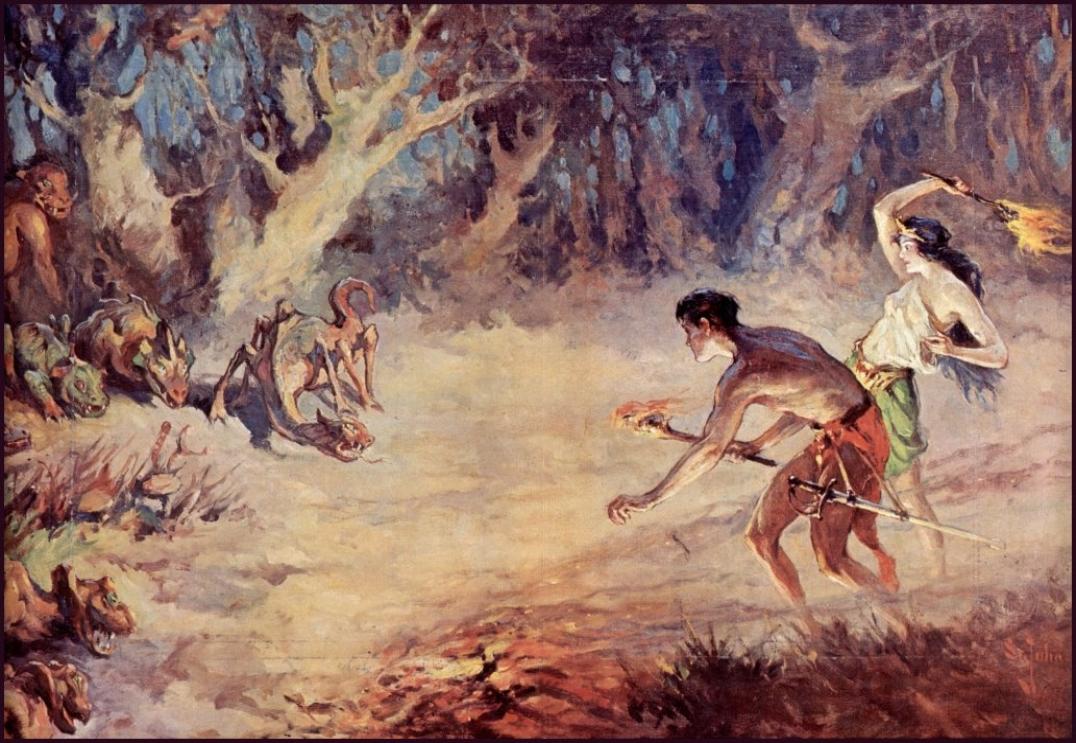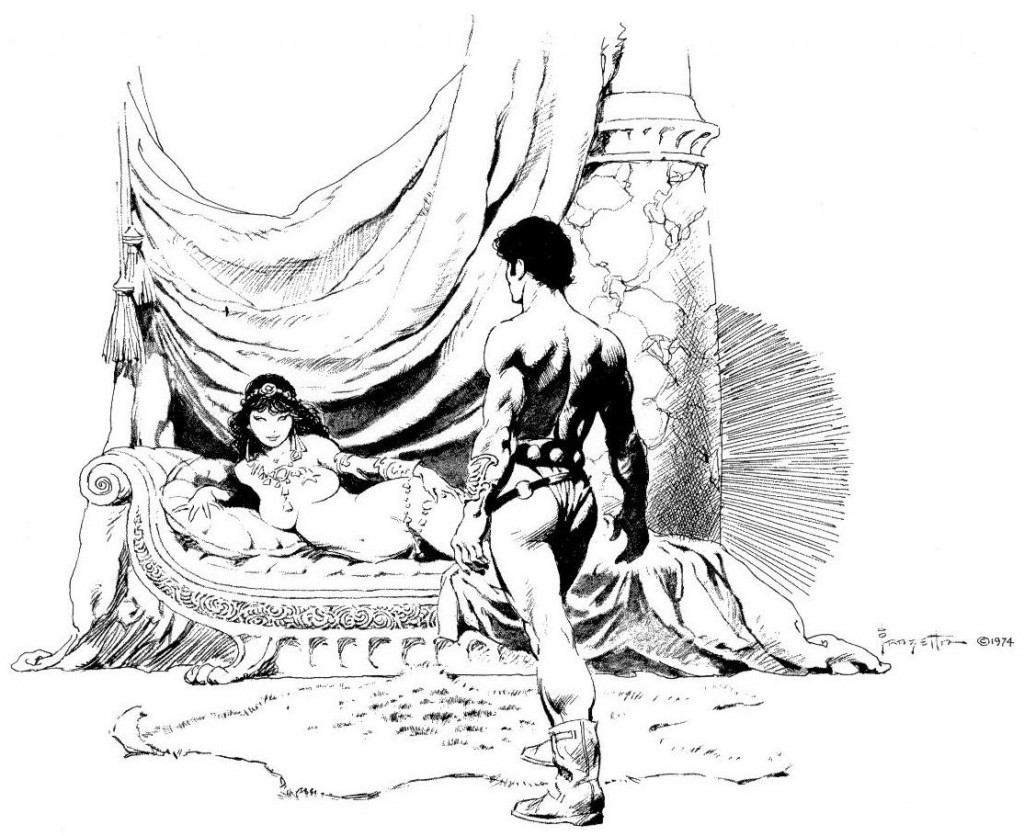 Welcome back John Carter! With the eighth book in the Barsoom series
the narrative switches back to the character who started it all;
released in 1936, in the pages of Blue Book, this six part serial was the first time we’d had a John Carter centric story since Warlord of Mars. No longer following the adventures of one of his kids, or other random adventurers, Swords of Mars
throws the greatest swordsman to ever live into dangers beyond his kin
and into the hands of a pair of dueling scientists. Be forewarned, Dejah
Thoris is kidnapped in the pages of this book. I know, this totally
shocked me as well.
Welcome back John Carter! With the eighth book in the Barsoom series
the narrative switches back to the character who started it all;
released in 1936, in the pages of Blue Book, this six part serial was the first time we’d had a John Carter centric story since Warlord of Mars. No longer following the adventures of one of his kids, or other random adventurers, Swords of Mars
throws the greatest swordsman to ever live into dangers beyond his kin
and into the hands of a pair of dueling scientists. Be forewarned, Dejah
Thoris is kidnapped in the pages of this book. I know, this totally
shocked me as well.Dying of old age on Barsoom isn’t something many people achieve; the average lifespan among the inhabitants of the Red Planet is about one thousand years, but as warfare is almost a constant state of affairs across the globe reaching that lofty age is rarely achieved. Before John Carter exposed the Holy Therns religious scam (back in Gods of Mars) one could take the long boat ride down the river Iss and an assumed paradise, but Carter spoiled all that by revealing that not only was there no god but that the pilgrims were either being enslaved or eaten. In Swords of Mars John Carter attempts to put a stop to another method of dying, and that would be assassination.
When John Carter led the Thark horde to sack the city Zodanga (back in A Princess of Mars) he didn’t make many friends, and as as one who does not let old enemies fester and plot Carter decided to wage against the resurgent Guild of Assassins, whose headquarters can be found in Zodanga. For a while he was satisfied to have his agents track down and kill any assassin that dared set foot inside his beloved Helium, but soon that wasn’t enough and he decided to take the war to their capital. Of course the infamous John Carter wouldn’t have much luck uncovering the Guild if he just walked around Zodanga looking for clues, he's kind of a notorious celebrity at this point, but with some nice applied red pigment he could easily pass as a soldier of fortune seeking employment.
The first half of Sword of Mars is basically a spy story with John Carter getting caught up in a hot bed of spies and murders; he meets small-time criminal Rapas the Ulsio (aka The Rat) who introduces him to Fal Sivas, a brilliant if a little mad scientist (as most proper scientists are) who is constructing a ship that can make interplanetary journeys. The reason Fal Sivas is in need of a strong sword arm working for him is that he has a dangerous rival in the form of Gar Nal, another scientist working on a spacecraft of his own. So long before America and Russia started their “Space Race” Mars was in the midst of their own.
While working for Fal Sivas John Carter is able to investigate the Guild of Assassins because Gar Nal has employed Ur Jan, the head of the Guild, to kill Fal Sivas. There is much fun to be had here as Rapas the Rat informs Ur Jan that Fal Sivas has hired a new bodyguard, and he offers to lead this poor sap into a trap. Unfortunately for this particular rat the intended victim over hears this plan and so instead of an assassin taking out some poor soldier of fortune he find himself dead on the blade of John Carter, Warlord of Mars. After repeated attempts fail to take out this “simple” solider the crafty Ur Jan realizes that the only man on Barsoom capable of killing off his best men is John Carter himself. Also Carter cuts an “X” into his victims, which was a mark he placed on previous assassins during his war against the Guild, and kind of a big tip-off as to who is behind it all. Carter may be a brilliant swordsman but his spy craft could use a little work.
During one of John Carter’s better spy moments he overhears that Ur Jan had put into motion a plan to kidnap a noble of Helium, so as to blackmail his enemies out of not only gold and jewels but to ensure that they leave his Guild business alone, and of course the target turns out to be Dejah Thoris *sigh* and they plan on hiding her on one of the Martian moons. Carter immediately races home but he's too late, so he races back to Zodanga to get the only ship with a chance of saving his true love. Soon John Carter will find himself sailing through the dark void of space where he will face cyclopean flesh eaters and invisible armies all in a quest to once again rescue his one true love.
John Carter’s skill as a swordsman will be put to the ultimate test but it’s his ability to think quickly on his feet that will be pushed to the limits here, and Swords of Mars is chock full of all the stuff that makes the Barsoom stories so great, but it also has some new and brilliant stuff to dazzle his readers.
What will thrill fans of science fiction is that in this story Edgar Rice Burroughs devised one of the early uses of computers in science fiction; the brilliant Fal Sivas had outfitted his spacecraft with a synthetic brain, and because he is a “mad scientist” he developed this brain by doing brain biopsies on living patients, studying how the brain works and transposing what learned to his ships artificial brain, and if that isn’t enough to thrill you the synthetic brain is also thought controlled. Fal Sivas explains to Carter that it isn’t a true brain; it cannot generate original thoughts of its own, but is reliant on commands by Fal Sivas himself. Thought controlled element aside this is a pretty good description of how advanced computers work, it can complete complicated tasks as long as it has proper directives. Eat your heart out Isaac Asimov.
A Barsoom story isn’t complete without the introduction of a new race or two; in Swords of Mars we encounter on the moon known as Thuria two distinct races; first there is the invisible sun-worshipping Tarids, who capture John Carter and company upon their arrival on the moon. The Tarids are not actually invisible, nor do they have some cloaking device that hides them from their enemies, but instead the Tarids had developed a hypnotic power as a protective device. They simply will their enemies to neither see nor hear them. Of course John Carter will be able to eventually break through this mental illusion, and after getting the Tarid queen to fall in love with him they escape.
Note: John Carter does not seduce the Tarid queen so that they can escape, this is just something that happens, and to be fair by this point it’s kind of like breathing when it comes to John Carter and women. Now Carter doesn’t let cop to the fact that Dejah Thoris (also a captive of the Tarids) is his wife because he is not an idiot, and jealousy has caused him much grief in the past, so though he doesn't intentionally seduce the Queen he also doesn’t exactly discourage her falling in love with him.
The second race that Carter encounters is the cat-like Umka, who he meets while imprisoned by the Tarids. He shares his cell with one of these one-eyed, two-mouthed grinning Cat-Men, who keeps changing color to blend with the background like a chameleon, and it’s from this Umka that Carter learns to speak the local language. When they do eventually escape the friendship he developed with this Cat-Man serves him in good stead as it saves Carter and the Queen from being eaten by his flesh-eating friends. Having the right friends has always been a key ingredient to survival in Burroughs land.
Swords of Mars has the usual backstabbing betrayals, though one villain has a nice change of heart, and there will be moments of sheer coincidence and good luck; so much so that one assume that John Carter was born with a horseshoe lodged up his butt and that he spends his free time rolling around in a pit of rabbits feet. Regardless of the formulaic moments that pop up in this series I found this book to be immensely fun and engaging, kind of makes reading a Burroughs book like slipping into a nice comfortable pair of shoes, and the more one reads Burroughs the more one realizes just how much of an impact he had on the genre.







No comments:
Post a Comment